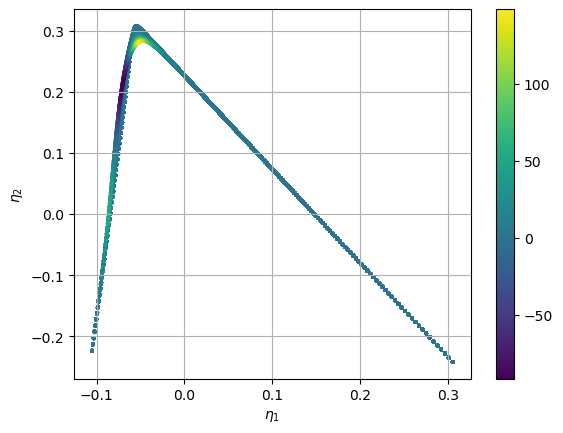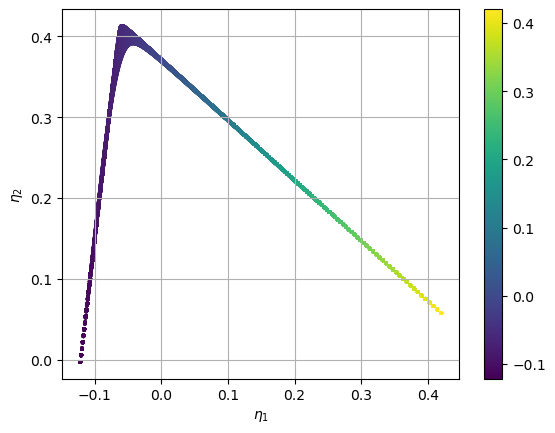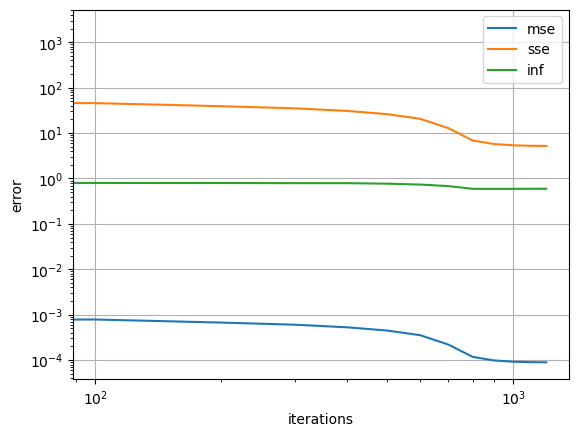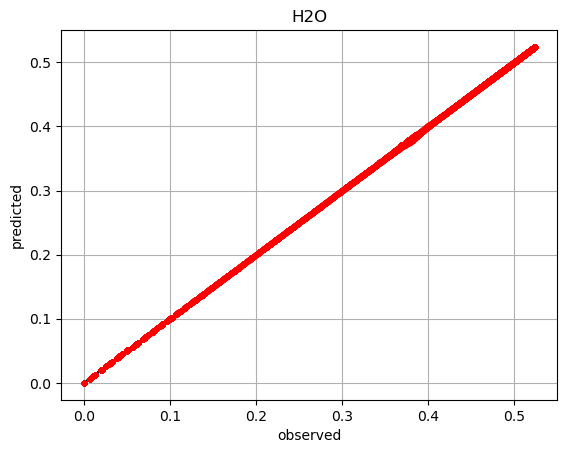Note
This tutorial was generated from a Jupyter notebook that can be accessed here.
QoI-aware encoder-decoders employing Partition of Unity Networks (POUnets)#
This demo takes the general formulation of QoI-aware encoder-decoders available in PCAfold and implements POUnets as the decoder.
from PCAfold import QoIAwareProjectionPOUnet, init_uniform_partitions, PCA, center_scale, PartitionOfUnityNetwork
import numpy as np
import matplotlib.pyplot as plt
import tensorflow.compat.v1 as tf
We will load the combustion dataset and remove temperature from the state variable list.
X = np.genfromtxt('H2-air-state-space.csv', delimiter=',')[:,1:-2]
S_X = np.genfromtxt('H2-air-state-space-sources.csv', delimiter=',')[:,1:-2]
X_names = np.genfromtxt('H2-air-state-space-names.csv', delimiter='\n', dtype=str)[1:-2]
X_names
array(['H', 'H2', 'O', 'OH', 'H2O', 'O2', 'HO2', 'H2O2'], dtype='<U4')
We then initialize the encoder weights using PCA. Notice how the 2D manifold is squeezed tightly and has overlapping states in some regions.
n_components = 2
pca = PCA(X, n_components=n_components, scaling='auto')
encoder_weights_init = pca.A[:,:n_components]
X_projected = X.dot(encoder_weights_init)
S_X_projected = S_X.dot(encoder_weights_init)
plt.scatter(X_projected[:,0], X_projected[:,1],s=3, c=S_X_projected[:,0], cmap='viridis')
plt.colorbar()
plt.grid()
plt.show()

Next, we finish initializing the encoder-decoder with the POUnet
parameters. The helper function init_uniform_partitions is used as
done in the POUnet demo, but note the independent variable space for the
POUnet is the projected state variables X_projected. We have chosen
a linear basis below.
When building the graph for the encoder-decoder, a function is required for computing the dependent training variables (QoIs). This allows for flexibility in using the projection parameters, which get updated themselves during training, for the dependent variable definitions. Therefore, the projection training can be informed by how well the projected source terms are represented, for example. The function must take in the encoder weights as an argument, but these do not have to be used. We also perform a nonlinear transformation on the source terms, which can help penalize projections introducing overlap in values. Below, we build a function that computes the projected source terms and concatenates these values with those of the OH and water mass fractions. These four variables provide the QoIs for which the loss function is computed during training. Note the QoI function must be written using tensorflow operations.
The graph is then built. Below we have turned on the optional
constrain_positivity flag. As mass fractions are naturally positive,
this only penalizes projections that create negative projected source
terms. This can have advantages in simplifying regression and reducing
the impact of regression errors with the wrong sign during simulation.
Finally, we train the QoIAwareProjectionPOUnet for 1000 iterations,
archiving every 100th iteration, and save the parameters with the lowest
overall errors. This is for demonstration, but more iterations are
generally needed to converge to an optimal solution.
ednet = QoIAwareProjectionPOUnet(encoder_weights_init,
**init_uniform_partitions([8,8], X_projected),
basis_type='linear'
)
# define the function to produce the dependent variables for training
def define_dvar(proj_weights):
dvar_y = tf.Variable(X[:,3:5], name='non_transform', dtype=tf.float64) # mass fractions for OH and H2O
dvar_s = tf.Variable(np.expand_dims(S_X, axis=2), name='non_transform', dtype=tf.float64)
dvar_s = ednet.tf_projection(dvar_s, nobias=True) # projected source terms
dvar_st = tf.math.sqrt(tf.cast(tf.abs(dvar_s+1.e-4), dtype=tf.float64)) * tf.math.sign(dvar_s+1.e-4)+1.e-2 * tf.math.sign(dvar_s+1.e-4) # power transform source terms
dvar_st_norm = dvar_st/tf.reduce_max(tf.cast(tf.abs(dvar_st), dtype=tf.float64), axis=0, keepdims=True) # normalize
dvar = tf.concat([dvar_y, dvar_st_norm], axis=1) # train on combination
return dvar
ednet.build_training_graph(X, define_dvar, error_type='abs', constrain_positivity=True)
ednet.train(1000, archive_rate=100, verbose=True)
------------------------------------------------------------
iteration | mean sqr | % max | sum sqr
------------------------------------------------------------
100 | 7.85e-04 | 79.79% | 4.56e+01
resetting best error
200 | 6.72e-04 | 79.53% | 3.91e+01
resetting best error
300 | 6.04e-04 | 78.90% | 3.51e+01
resetting best error
400 | 5.29e-04 | 78.87% | 3.07e+01
resetting best error
500 | 4.49e-04 | 76.84% | 2.61e+01
resetting best error
600 | 3.53e-04 | 73.46% | 2.05e+01
resetting best error
700 | 2.20e-04 | 67.99% | 1.28e+01
resetting best error
800 | 1.18e-04 | 59.24% | 6.86e+00
resetting best error
900 | 9.86e-05 | 59.00% | 5.73e+00
resetting best error
1000 | 9.25e-05 | 59.07% | 5.37e+00
resetting best error
The learning rate (default 1e-3) and least squares l2 regularization (default 1e-10) can also be updated at any time.
ednet.update_lr(1.e-4)
ednet.update_l2reg(1.e-11)
ednet.train(200, archive_rate=100, verbose=True)
updating lr: 0.0001
updating l2reg: 1e-11
------------------------------------------------------------
iteration | mean sqr | % max | sum sqr
------------------------------------------------------------
100 | 9.03e-05 | 59.40% | 5.25e+00
resetting best error
200 | 8.96e-05 | 59.41% | 5.21e+00
resetting best error
We can look at the trained projection weights:
print(ednet.projection_weights)
[[-0.35640105 0.05729153]
[ 0.42022997 0.05765012]
[-0.48311619 -0.24169431]
[-0.24244533 -0.20839019]
[-0.11743472 0.78807212]
[-0.24317541 -0.00543714]
[-1.16916608 -0.3213446 ]
[-1.52308699 0.10786119]]
We can look at the projection after the progress in training. We see how the projected source term values are closer to being positive than before and the overlap has been removed. We would expect further training to create more separation between observations. Other QoIs for training may also lead to better separation faster.
X_projected = ednet.projection(X)
S_X_projected = ednet.projection(X, nobias=True)
plt.scatter(X_projected[:,0], X_projected[:,1],s=3, c=S_X_projected[:,0], cmap='viridis')
plt.colorbar()
plt.grid()
plt.show()

Below we grab the archived states during training and visualize the errors.
err_dict = ednet.training_archive
for k in ['mse', 'sse', 'inf']:
plt.loglog(ednet.iterations,err_dict[k],'-', label=k)
plt.grid()
plt.xlabel('iterations')
plt.ylabel('error')
plt.legend()
plt.show()

We may also save and load a QoIAwareProjectionPOUnet to/from file.
Rebuilding the graph is not necessary to grab the projection off a
loaded QoIAwareProjectionPOUnet.
# Save the data to a file
ednet.write_data_to_file('filename.pkl')
# reload projection data from file
ednet2 = QoIAwareProjectionPOUnet.load_from_file('filename.pkl')
#compute projection without needing to rebuild graph:
X_projected = ednet2.projection(X)
It can then be useful to create multiple POUnets for separate variables
using the same trained projection and partitions from the
QoIAwareProjectionPOUnet. Below we demonstrate this for the water
mass fraction.
net = PartitionOfUnityNetwork(
partition_centers=ednet.partition_centers,
partition_shapes=ednet.partition_shapes,
basis_type=ednet.basis_type,
ivar_center=ednet.proj_ivar_center,
ivar_scale=ednet.proj_ivar_scale
)
i_dvar = 4
dvar1 = X[:,i_dvar]
net.build_training_graph(ednet.projection(X), dvar1)
net.lstsq()
pred = net(ednet.projection(X))
plt.plot(dvar1, dvar1, 'k-')
plt.plot(dvar1, pred.ravel(), 'r.')
plt.title(X_names[i_dvar])
plt.grid()
plt.show()
performing least-squares solve

There is also an option when building the QoIAwareProjectionPOUnet
graph of separating trainable from nontrainable projection weights. This
can be useful if certain dimensions of the projection are predefined,
such as mixture fraction commonly used in combustion. In order to set
certain columns of the projection weight matrix constant, specify the
first index for which the weights are trainable
(first_trainable_idx).
Below is an example of holding the first weights constant. We see how the second weights change after training, but the first do not.
ednet2 = QoIAwareProjectionPOUnet.load_from_file('filename.pkl')
ednet2.build_training_graph(X, define_dvar, first_trainable_idx=1)
old_weights = ednet2.projection_weights
ednet2.train(10, archive_rate=1)
print('difference in weigths before and after training:\n', old_weights-ednet2.projection_weights)
difference in weigths before and after training:
[[ 0. -0.001 ]
[ 0. -0.001 ]
[ 0. -0.001 ]
[ 0. -0.001 ]
[ 0. 0.001 ]
[ 0. 0.001 ]
[ 0. 0.001 ]
[ 0. 0.0009999]]